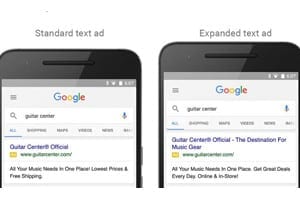 In an effort to streamline and improve the mobile experience, Google has launched expanded text ads (ETAs).
In an effort to streamline and improve the mobile experience, Google has launched expanded text ads (ETAs).
Already accessible to advertisers, ETAs will become Google’s only form of text ad by early 2017. That means standard text ads (STAs) will become obsolete in the New Year.
Early ETA adopters are currently experiencing better ad-performance, all while gathering crucial metrics on what the best ETA content is for their campaigns.
The Basics of ETAs
What are expanded text ads? Like the name suggests, ETAs are text ads with a larger character limit and more fields.
The key new features of ETAs are a second headline (H2) and an expanded description line. Unlike STAs, ETAs have two 30-character headlines and one 80-character description.
Having two headlines and a longer description allows for many new advertising venues, but keep in mind ETAs still need to meet the editorial requirements of all past Google ads.
Migrating to ETAs, however, isn’t a science. The best migration strategies will depend on context such as vertical, market and competition, etc. There are no rules; every advertiser needs to experiment to discover what works for them.
Testing ETAs
In order to know what migration strategy will work best, it’s important to run experiments where the performance of the best STA is compared with a migrated STA and a newly written ETA. The goal is to generate quantitative data on the relative performance of these ads.
Before we delve into ETA marketing strategies, it’s important to note that, even though ETAs were created with mobile-users in mind, ETAs do not have a mobile preference.
That fact may influence how you want to implement ETA testing, as it gives you a few options.
You can either choose to create new ETA campaigns for each specific device (mobile, desktop) and track how they perform alongside your current STAs or create an ETA campaign across all platforms.
Another option is leaving mobile ads untouched, since they tend to perform better in general, and test out new ETAs on desktop/tablet campaigns.
The choice is yours and will depend on your unique brand and business.
Regardless of what route you take, an essential step is to pause down your current ads, except for those you want to test. By having all your old STA and new ETA ads running at the same time, you won’t get enough data to track how the ETAs are performing.
If the migrated ad performs better than the STA, record the data and move onto another STA. If not, then it’s back to the migration plan drawing board. Some newly written ETAs might perform so well you’ll decide it’s worthwhile to rewrite more STAs as ETAs rather than migrating. It really depends upon the value that rewriting brings to your business.
Tips On Creating ETAs
- When it comes to formatting ETAs themselves, the possibilities are endless. More characters gives you more room to experiment, but certain techniques are already working for many advertisers.
- The simplest method of making an ETA is to take your old description line 2 (D2) and make it your new H2. Yes, it sounds strange, but you’d be surprised by the extra performance that brings.
- Another option is to place a call to action in your H2, or a consumer benefit.
- Don’t limit changes to your H2, either. Try flipping your existing H1 with an H2 and see how the ad performs.
- Make the most out of the longer character limit for your description, too. While a new description may not have the same impact as an H2, that doesn’t mean you should ignore the value it adds to a campaign. Try inserting a unique feature of a product or a business benefit in the description alongside a call to action, since you have the room.
- Of course, you could always just start from scratch and create a brand new ETA. Sometimes a fresh perspective works best.
What’s most important to remember is that you need to test your ETAs with all sorts of new configurations. Sample some of the strategies outlined above and track how each ETA-configuration performs. And consider this Migration Testing Flow Chart as a handy guide for testing.
Richard Beck is the AdPlatform product manager for Acquisio.
Related Articles:
Modern Marketing Health Check: Mastering Martech—4 Things to Consider
How to Defend Higher Digital Ad Budgets in 2017
How Leading CMOs are Planning Marketing Budgets for 2017
 Network
Network

